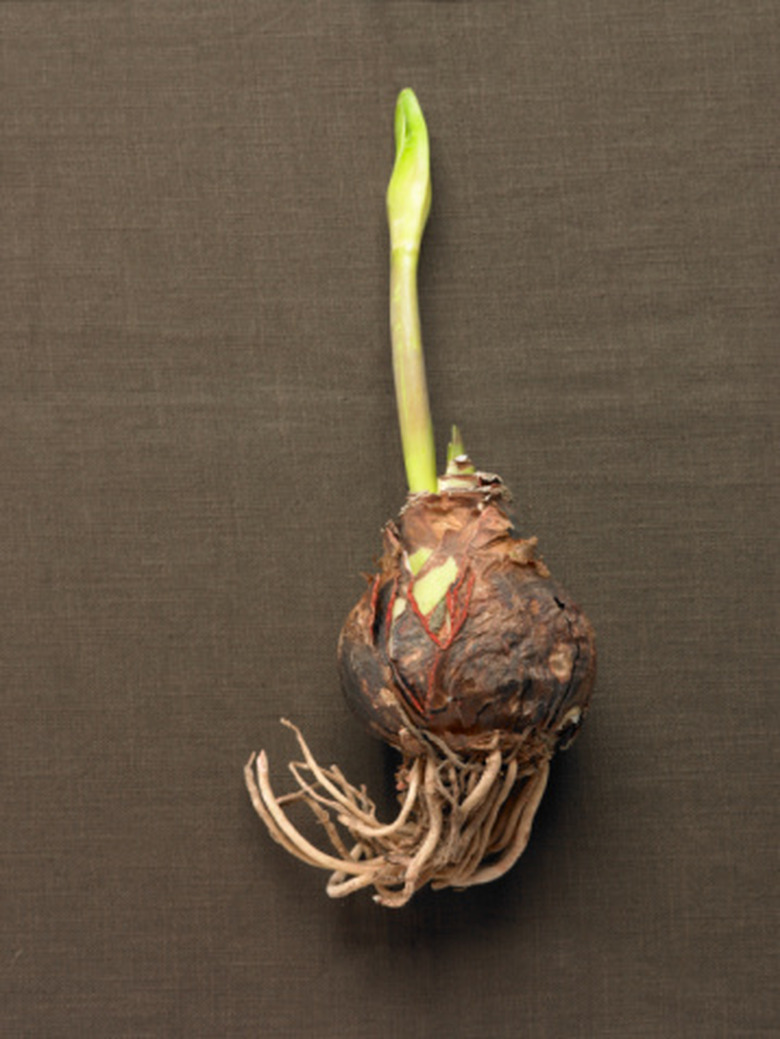How To Identify Bulbs
Things Needed
- Old newspapers
- Pictorial chart and verbal descriptions
- Small brown paper lunch bags
As gardening has increased in popularity, some gardeners have taken for granted the old-fashioned pictorial chart showing how to plant bulbs. One of the nicest conveniences of that chart was the drawings of bulbs attached to the blooming flowers they can produce. We'll never know how many instant experts that now hard-to-find chart created. There is a link in the Resources section to a copy of the chart that you can tape to your garage wall. Use pictures and the verbal descriptions that now meet the needs of more experienced and more adventuresome gardeners to identify old bulbs in your yard or new ones in the bargain bin.
Sorting Strategies and Terms
Step 1
Lay out all the bulbs you're trying to identify on a newspaper or flat surface. Remove any bulbs with the following characteristics: soaking wet and squashy; leaking liquids; the same dark brown color all the way through; or cut in pieces. Throw them away, as they're very likely to be too damaged to grow any more.
- As gardening has increased in popularity, some gardeners have taken for granted the old-fashioned pictorial chart showing how to plant bulbs.
- Use pictures and the verbal descriptions that now meet the needs of more experienced and more adventuresome gardeners to identify old bulbs in your yard or new ones in the bargain bin.
Step 2
Sort bulbs by both shape and size. Shapes tend to include: tear-drop; flattened-ball; round at the bottom with two or more similar-sized points at the top; egg-shaped; or heavily pointed, like lumpy cow horns. Sizes can run from the size of your thumbnail to larger than a golf ball.
Step 3
Make separate piles of bulbs shaped like bunches of carrots or flattened round couch cushions. The carrot-shaped clusters are technically tubers; the couch cushions are corms. For sorting and planting purposes, however, corms and tubers qualify as bulbs. Bulbs are self-contained plant factories, needing very little help to grow to a mature plant.
- Sort bulbs by both shape and size.
- The carrot-shaped clusters are technically tubers; the couch cushions are corms.
Making Specific Identifications
Step 1
Divide tear-drop-shaped, golf ball-sized bulbs into two piles, depending on their outer paper-like skin. Those bulbs with a single sheet of smooth brown skin are tulips. Those with several layers of purple, reddish, bluish or cream-color papery skin are hyacinths. A hint with hyacinths: sometimes the outer layers give you a clue about the bloom color–and sometimes they don't. If you still have teardrops left with several layers of papery tan-to-brown skin, separate them for now.
Step 2
Make piles of your other large, ball-sized, bulbs. Your biggest teardrops are likely to be one of two kinds. Big, big bulbs are probably Fritillary or Crown Imperial. Big bulbs that smell like onions will likely be Decorative Alliums, which smell like onions because they belong to the onion family.
- Divide tear-drop-shaped, golf ball-sized bulbs into two piles, depending on their outer paper-like skin.
Step 3
Put middle-sized teardrops and bulbs shaped like lumpy cow-horns together. They should have in common several layers of papery tan-to-brown skin–the overlapping of layers is most visible at the pointy end. Bulbs with two or more points are said to have double or triple noses. With one, two or more noses, these bulbs are daffodils. Each nose contains a leaf-and-flower sprout. When the noses reach golf ball size, separate them gently, making sure each nose has a few roots. This is how daffodils reproduce. You have just turned one plant into many.
- Put middle-sized teardrops and bulbs shaped like lumpy cow-horns together.
- With one, two or more noses, these bulbs are daffodils.
Step 4
Separate small bulbs into piles. Since many are very close to the same size, sort them by the quality of their covering skin. As you look closely, you'll notice that some coverings are heavily grooved, very smooth or extremely thin. When you're sorting large quantities of mixed, small, early spring bulbs, sorting is further confused by mature vs. immature sizes and the complete absence of covering on some bulbs. Use your pictures and charts to clarify what is what, and plan a little replanting after blooming.
Tip
Once you've sorted out bulbs, you might consider putting each variety into a small brown paper bag and writing the bulb name on the bag. After all that work, it may seem silly to label something you'll put in the ground tomorrow; surely you'll remember. But many expert gardeners greet spring with the words, "What do you suppose that is?"
Warning
If bulbs have been dug out of the ground for sorting, a few may wind up in the wrong categories. As soon as blooms fade, gently remove the "outsider" and transplant it at once.
